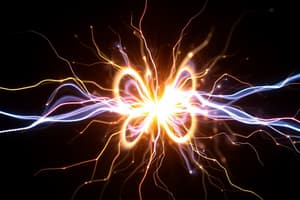Podcast
Questions and Answers
Like charges attract each other.
Like charges attract each other.
False (B)
Electric charge is a property of atomic particles.
Electric charge is a property of atomic particles.
False (B)
Coulomb's law is used to describe the interaction between electric charges.
Coulomb's law is used to describe the interaction between electric charges.
True (A)
The superposition principle states that the force between two charged objects is always repulsive.
The superposition principle states that the force between two charged objects is always repulsive.
Electric field lines are used to visualize the magnetic field around a charged object.
Electric field lines are used to visualize the magnetic field around a charged object.
Electric field lines originate from negative charges and terminate at positive charges.
Electric field lines originate from negative charges and terminate at positive charges.
Coulomb's law can be used to calculate the electric force between two large objects, such as planets.
Coulomb's law can be used to calculate the electric force between two large objects, such as planets.
Coulomb's law is a fundamental principle in electrostatics that helps us understand the behavior of electric charges.
Coulomb's law is a fundamental principle in electrostatics that helps us understand the behavior of electric charges.
The density of electric field lines provides an indication of the weakness of the electric field in a given region.
The density of electric field lines provides an indication of the weakness of the electric field in a given region.
Coulomb's law has applications in physics, engineering, and other fields.
Coulomb's law has applications in physics, engineering, and other fields.
Study Notes
Coulomb's Law: Understanding the Basics of Electric Charge
Overview
Coulomb's law, named after Charles-Augustin de Coulomb, is an experimental law that quantifies the amount of force between two stationary electrically charged objects. It was developed in the 18th century and has been a cornerstone of our understanding of electrostatic force. This article will delve into the key concepts of Coulomb's law, focusing on the subtopic of electric charge.
Electric Charge
Properties of Charge
Electric charge is a property of subatomic particles, such as electrons and protons. Like charges repel each other, while unlike charges attract. The importance of Coulomb's law lies in its ability to describe the interaction between these charges, which is a central force in our understanding of electrostatics.
Superposition Principle
One of the fundamental principles of Coulomb's law is the superposition principle, which states that the force between two charged objects can be calculated by adding the forces due to each charge separately. This means that the electric force between multiple charged objects can be determined by treating each charge as a separate source of force.
Electric Field Lines
To visualize the electric field around a charged object, we can use electric field lines. These lines are imaginary lines that represent the direction and magnitude of the electric force between the charged object and other charges. The lines originate from positive charges and terminate at negative charges. The density of the lines provides an indication of the strength of the electric field in a given region.
Coulomb's Law
Formula
Coulomb's law can be expressed mathematically as:
[ F = k \frac{q_0 q_1}{r^2} ]
where:
- (F) is the electric force between two charged objects,
- (k) is a constant,
- (q_0) and (q_1) are the charges on the two objects, and
- (r) is the distance between the centers of the two charged objects.
Applications of Coulomb's Law
Coulomb's law has numerous applications in physics, engineering, and other fields. It is used to understand and predict the behavior of charged objects in various situations, such as in the design of capacitors, the operation of electromagnets, and the effects of lightning.
Limitations of Coulomb's Law
Coulomb's law is applicable only for point charges that are at rest and in situations where the inverse square law is obeyed. It cannot be used directly to calculate the charge on large objects, such as planets, as it assumes that the charges are point-like.
Conclusion
In summary, Coulomb's law is a fundamental principle in electrostatics that helps us understand the behavior of electric charges. It allows us to calculate the electric force between two charged objects, which is essential for predicting and understanding the interactions between charged particles in various situations. As we continue to explore the world of electrostatics, we'll encounter more complex scenarios and phenomena, but Coulomb's law will remain a cornerstone of our understanding of electric charge.
Studying That Suits You
Use AI to generate personalized quizzes and flashcards to suit your learning preferences.
Description
Explore the fundamentals of Coulomb's law, including the properties of electric charge, the superposition principle, and electric field lines. Learn how to calculate the electric force between two charged objects and discover the applications and limitations of this essential principle in electrostatics.




